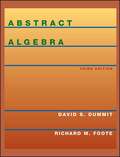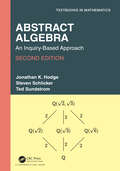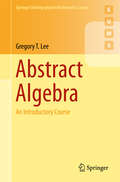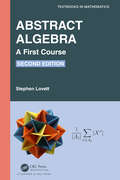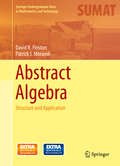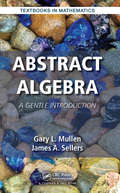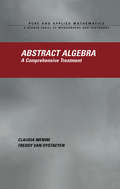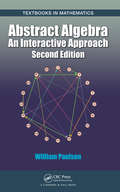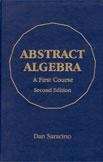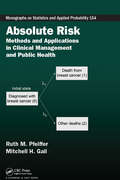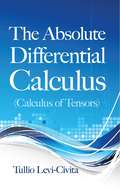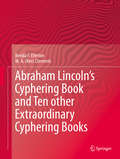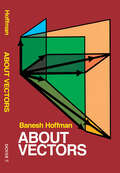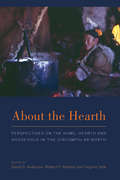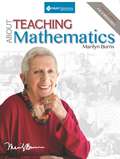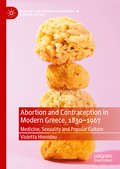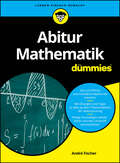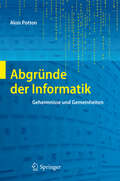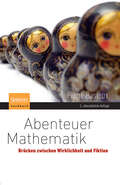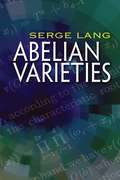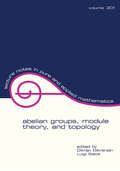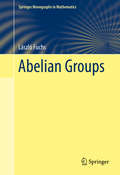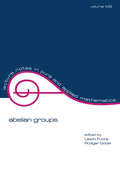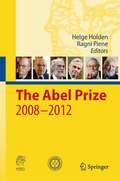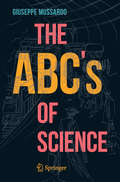- Table View
- List View
Abstract Algebra
by David S. Dummit Richard M. FooteThis revision of Dummit and Foote's widely acclaimed introduction to abstract algebra helps students experience the power and beauty that develops from the rich interplay between different areas of mathematics. The book carefully develops the theory of different algebraic structures, beginning from basic definitions to some in-depth results, using numerous examples and exercises to aid the student's understanding. With this approach, students gain an appreciation for how mathematical structures and their interplay lead to powerful results and insights in a number of different settings. <P><P> The text is designed for a full-year introduction to abstract algebra at the advanced undergraduate or graduate level, but contains substantially more material than would normally be covered in one year. Portions of the book may also be used for various one-semester topics courses in advanced algebra, each of which would provide a solid background for a follow-up course delving more deeply into one of many possible areas: algebraic number theory, algebraic topology, algebraic geometry, representation theory, Lie groups, etc.
Abstract Algebra: An Inquiry-Based Approach (Textbooks in Mathematics)
by Jonathan K. Hodge Steven Schlicker Ted SundstromAbstract Algebra: An Inquiry-Based Approach, Second Edition not only teaches abstract algebra, but also provides a deeper understanding of what mathematics is, how it is done, and how mathematicians think. The second edition of this unique, flexible approach builds on the success of the first edition. The authors offer an emphasis on active learning, helping students learn algebra by gradually building both their intuition and their ability to write coherent proofs in context. The goals for this text include: Allowing the flexibility to begin the course with either groups or rings. Introducing the ideas behind definitions and theorems to help students develop intuition. Helping students understand how mathematics is done. Students will experiment through examples, make conjectures, and then refine or prove their conjectures. Assisting students in developing their abilities to effectively communicate mathematical ideas. Actively involving students in realizing each of these goals through in-class and out-of-class activities, common in-class intellectual experiences, and challenging problem sets. Changes in the Second Edition Streamlining of introductory material with a quicker transition to the material on rings and groups. New investigations on extensions of fields and Galois theory. New exercises added and some sections reworked for clarity. More online Special Topics investigations and additional Appendices, including new appendices on other methods of proof and complex roots of unity. Encouraging students to do mathematics and be more than passive learners, this text shows students the way mathematics is developed is often different than how it is presented; definitions, theorems, and proofs do not simply appear fully formed; mathematical ideas are highly interconnected; and in abstract algebra, there is a considerable amount of intuition to be found.
Abstract Algebra: An Introductory Course (Springer Undergraduate Mathematics Series #First Edition)
by Gregory T. Lee<P>This carefully written textbook offers a thorough introduction to abstract algebra, covering the fundamentals of groups, rings and fields. <P> The first two chapters present preliminary topics such as properties of the integers and equivalence relations. The author then explores the first major algebraic structure, the group, progressing as far as the Sylow theorems and the classification of finite abelian groups. An introduction to ring theory follows, leading to a discussion of fields and polynomials that includes sections on splitting fields and the construction of finite fields. The final part contains applications to public key cryptography as well as classical straightedge and compass constructions. <P> Explaining key topics at a gentle pace, this book is aimed at undergraduate students. It assumes no prior knowledge of the subject and contains over 500 exercises, half of which have detailed solutions provided.
Abstract Algebra: A First Course (Textbooks in Mathematics)
by Stephen LovettWhen a student of mathematics studies abstract algebra, he or she inevitably faces questions in the vein of, "What is abstract algebra" or "What makes it abstract?" Algebra, in its broadest sense, describes a way of thinking about classes of sets equipped with binary operations. In high school algebra, a student explores properties of operations (+, −, ×, and ÷) on real numbers. Abstract algebra studies properties of operations without specifying what types of number or object we work with. Any theorem established in the abstract context holds not only for real numbers but for every possible algebraic structure that has operations with the stated properties. This textbook intends to serve as a first course in abstract algebra. The selection of topics serves both of the common trends in such a course: a balanced introduction to groups, rings, and fields; or a course that primarily emphasizes group theory. The writing style is student-centered, conscientiously motivating definitions and offering many illustrative examples. Various sections or sometimes just examples or exercises introduce applications to geometry, number theory, cryptography and many other areas. This book offers a unique feature in the lists of projects at the end of each section. the author does not view projects as just something extra or cute, but rather an opportunity for a student to work on and demonstrate their potential for open-ended investigation. The projects ideas come in two flavors: investigative or expository. The investigative projects briefly present a topic and posed open-ended questions that invite the student to explore the topic, asking and to trying to answer their own questions. Expository projects invite the student to explore a topic with algebraic content or pertain to a particular mathematician’s work through responsible research. The exercises challenge the student to prove new results using the theorems presented in the text. The student then becomes an active participant in the development of the field.
Abstract Algebra: Structure and Application (Springer Undergraduate Texts in Mathematics and Technology)
by Patrick J. Morandi David R. FinstonThis text seeks to generate interest in abstract algebra by introducing each new structure and topic via a real-world application. The down-to-earth presentation is accessible to a readership with no prior knowledge of abstract algebra. Students are led to algebraic concepts and questions in a natural way through their everyday experiences. Applications include: Identification numbers and modular arithmetic (linear) error-correcting codes, including cyclic codes ruler and compass constructions cryptography symmetry of patterns in the real plane Abstract Algebra: Structure and Application is suitable as a text for a first course on abstract algebra whose main purpose is to generate interest in the subject or as a supplementary text for more advanced courses. The material paves the way to subsequent courses that further develop the theory of abstract algebra and will appeal to students of mathematics, mathematics education, computer science, and engineering interested in applications of algebraic concepts.
Abstract Algebra: A Gentle Introduction (Textbooks in Mathematics)
by Gary L. Mullen James A. SellersAbstract Algebra: A Gentle Introduction advantages a trend in mathematics textbook publishing towards smaller, less expensive and brief introductions to primary courses. The authors move away from the ‘everything for everyone’ approach so common in textbooks. Instead, they provide the reader with coverage of numerous algebraic topics to cover the most important areas of abstract algebra. Through a careful selection of topics, supported by interesting applications, the authors Intend the book to be used for a one-semester course in abstract algebra. It is suitable for an introductory course in for mathematics majors. The text is also very suitable for education majors who need to have an introduction to the topic. As textbooks go through various editions and authors employ the suggestions of numerous well-intentioned reviewers, these book become larger and larger and subsequently more expensive. This book is meant to counter that process. Here students are given a "gentle introduction," meant to provide enough for a course, yet also enough to encourage them toward future study of the topic. Features Groups before rings approach Interesting modern applications Appendix includes mathematical induction, the well-ordering principle, sets, functions, permutations, matrices, and complex nubers. Numerous exercises at the end of each section Chapter "Hint and Partial Solutions" offers built in solutions manual
Abstract Algebra: A Comprehensive Treatment (Pure and Applied Mathematics #267)
by Freddy Van Oystaeyen Claudia MeniniIn one exceptional volume, Abstract Algebra covers subject matter typically taught over the course of two or three years and offers a self-contained presentation, detailed definitions, and excellent chapter-matched exercises to smooth the trajectory of learning algebra from zero to one. Field-tested through advance use in the ERASMUS educational project in Europe, this ambitious, comprehensive book includes an original treatment of representation of finite groups that avoids the use of semisimple ring theory and explains sets, maps, posets, lattices, and other essentials of the algebraic language; Peano's axioms and cardinality; groupoids, semigroups, monoids, groups; and normal subgroups.
Abstract Algebra: An Interactive Approach (Second Edition) (Textbooks in Mathematics)
by William Paulsen<p>The new edition of Abstract Algebra: An Interactive Approach presents a hands-on and traditional approach to learning groups, rings, and fields. It then goes further to offer optional technology use to create opportunities for interactive learning and computer use. This new edition offers a more traditional approach offering additional topics to the primary syllabus placed after primary topics are covered. This creates a more natural flow to the order of the subjects presented. This edition is transformed by historical notes and better explanations of why topics are covered. <p>This innovative textbook shows how students can better grasp difficult algebraic concepts through the use of computer programs. It encourages students to experiment with various applications of abstract algebra, thereby obtaining a real-world perspective of this area. Each chapter includes, corresponding Sage notebooks, traditional exercises, and several interactive computer problems that utilize Sage and Mathematica® to explore groups, rings, fields and additional topics. This text does not sacrifice mathematical rigor. It covers classical proofs, such as Abel’s theorem, as well as many topics not found in most standard introductory texts. The author explores semi-direct products, polycyclic groups, Rubik’s Cube®-like puzzles, and Wedderburn’s theorem. The author also incorporates problem sequences that allow students to delve into interesting topics, including Fermat’s two square theorem.</p>
Abstract Algebra: A First Course
by Dan SaracinoThis book is intended for use in a junior-senior level course in abstract algebra. The Second Edition of this text maintains the clear exposition, logical organization, and accessible breadth of coverage that have been its hallmarks. It plunges directly into algebraic structures and incorporates a large number of examples to clarify abstract concepts as they arise. Proofs of theorems do more than just prove the stated results; Saracino examines them so readers gain a better impression of where the proofs come from and why they proceed as they do. Most of the exercises range from easy to moderately difficult and ask for understanding of ideas rather than flashes of insight. The new edition introduces five new sections on field extensions and Galois theory, increasing its versatility by making it appropriate for a two-semester as well as a one-semester course.
Absolute Risk: Methods and Applications in Clinical Management and Public Health (Chapman & Hall/CRC Monographs on Statistics and Applied Probability)
by Ruth M. Pfeiffer Mitchell H. GailAbsolute Risk: Methods and Applications in Clinical Management and Public Health provides theory and examples to demonstrate the importance of absolute risk in counseling patients, devising public health strategies, and clinical management. The book provides sufficient technical detail to allow statisticians, epidemiologists, and clinicians to build, test, and apply models of absolute risk. Features: Provides theoretical basis for modeling absolute risk, including competing risks and cause-specific and cumulative incidence regression Discusses various sampling designs for estimating absolute risk and criteria to evaluate models Provides details on statistical inference for the various sampling designs Discusses criteria for evaluating risk models and comparing risk models, including both general criteria and problem-specific expected losses in well-defined clinical and public health applications Describes many applications encompassing both disease prevention and prognosis, and ranging from counseling individual patients, to clinical decision making, to assessing the impact of risk-based public health strategies Discusses model updating, family-based designs, dynamic projections, and other topics Ruth M. Pfeiffer is a mathematical statistician and Fellow of the American Statistical Association, with interests in risk modeling, dimension reduction, and applications in epidemiology. She developed absolute risk models for breast cancer, colon cancer, melanoma, and second primary thyroid cancer following a childhood cancer diagnosis. Mitchell H. Gail developed the widely used "Gail model" for projecting the absolute risk of invasive breast cancer. He is a medical statistician with interests in statistical methods and applications in epidemiology and molecular medicine. He is a member of the National Academy of Medicine and former President of the American Statistical Association. Both are Senior Investigators in the Division of Cancer Epidemiology and Genetics, National Cancer Institute, National Institutes of Health.
The Absolute Differential Calculus: Calculus Of Tensors (Dover Books on Mathematics)
by Tullio Levi-CivitaWritten by a towering figure of twentieth-century mathematics, this classic examines the mathematical background necessary for a grasp of relativity theory. Tullio Levi-Civita provides a thorough treatment of the introductory theories that form the basis for discussions of fundamental quadratic forms and absolute differential calculus, and he further explores physical applications.Part one opens with considerations of functional determinants and matrices, advancing to systems of total differential equations, linear partial differential equations, algebraic foundations, and a geometrical introduction to theory. The second part addresses covariant differentiation, curvature-related Riemann's symbols and properties, differential quadratic forms of classes zero and one, and intrinsic geometry. The final section focuses on physical applications, covering gravitational equations and general relativity.
Abraham Lincoln’s Cyphering Book and Ten other Extraordinary Cyphering Books
by M. A. Ken Clements Nerida F. EllertonThis well-illustrated book provides strong qualitative and comparative support for the main arguments developed by Nerida Ellerton and Ken Clements in their groundbreaking Rewriting this History of School Mathematics in North America 1607-1861: The Central Role of Cyphering Books. Eleven extraordinary handwritten school mathematics manuscripts are carefully analyzed--six were prepared entirely in Great Britain, four entirely in North America, and 1 partly in Great Britain and partly in North America. The earliest of the 11 cyphering books was prepared around 1630, and the latest in 1835. Seven of the manuscripts were arithmetic cyphering books; three were navigation cyphering books, and one was a mensuration/surveying manuscript. One of the cyphering books examined in this book was prepared, over the period 1819-1826, by a young Abraham Lincoln, when he was attending small one-teacher schools in remote Spencer County, Indiana. Chapter 6 in this book provides the first detailed analysis of young Abraham's cyphering book--which is easily the oldest surviving Lincoln manuscript. Another cyphering book, this one prepared by William Beattie in 1835, could have been prepared as a special gift for the King of England. The analyses make clear the extent of the control which the cyphering tradition had over school mathematics in North America and Great Britain between 1630 and 1840. In their final chapter Ellerton and Clements identify six lessons from their research into the cyphering tradition which relate to present-day circumstances surrounding school mathematics. These lessons are concerned with sharp differences between intended, implemented and attained curricula, the remarkable value that many students placed upon their cyphering books, the ethnomathematical circumstances which surrounded the preparations of the extraordinary cyphering books, and qualitative differences between British and North American school mathematics.
About Vectors (Dover Books on Mathematics)
by Banesh HoffmannFrom his unusual beginning in "Defining a vector" to his final comments on "What then is a vector?" author Banesh Hoffmann has written a book that is provocative and unconventional. In his emphasis on the unresolved issue of defining a vector, Hoffmann mixes pure and applied mathematics without using calculus. The result is a treatment that can serve as a supplement and corrective to textbooks, as well as collateral reading in all courses that deal with vectors. Major topics include vectors and the parallelogram law; algebraic notation and basic ideas; vector algebra; scalars and scalar products; vector products and quotients of vectors; and tensors. The author writes with a fresh, challenging style, making all complex concepts readily understandable. Nearly 400 exercises appear throughout the text. Professor of Mathematics at Queens College at the City University of New York, Banesh Hoffmann is also the author of The Strange Story of the Quantum and other important books. This volume provides much that is new for both students and their instructors, and it will certainly generate debate and discussion in the classroom.
About the Hearth
by David G. Anderson Virginie Vate Robert P. WishartDue to changing climates and demographics, questions of policy in the circumpolar north have focused attention on the very structures that people call home. Dwellings lie at the heart of many forms of negotiation. Based on years of in-depth research, this book presents and analyzes how the people of the circumpolar regions conceive, build, memorialize, and live in their dwellings. This book seeks to set a new standard for interdisciplinary work within the humanities and social sciences and includes anthropological work on vernacular architecture, environmental anthropology, household archaeology and demographics.
About Teaching Mathematics: A K-8 Resource
by Marilyn BurnsIn this fourth edition of her signature resource, Marilyn presents her current thinking and insights and includes ideas from her most recent teaching experiences. <P><P> Part 1, “Starting Points,” reflects the major overhaul of this book and addresses twenty-three issues important to thinking about teaching mathematics today. Part 2, “Problem-Solving Investigations,” opens with how to plan problem-solving lessons; followed by whole-class, small-group, and individual investigations organized into five areas of the curriculum: Measurement, Data, Geometry, Patterns and Algebraic Thinking, and Number and Operations. Part 3, “Teaching Arithmetic,” focuses on the cornerstone of elementary mathematics curriculum, offering ideas and assessments that build students’ understanding, confidence, and competence in arithmetic. In Part 4, “Questions Teachers Ask,” features Marilyn’s responses to pedagogical questions she’s received from teachers over the years. <P><P> More than forty reproducibles for About Teaching Mathematics are available to download in a printable format.
Abortion and Contraception in Modern Greece, 1830-1967: Medicine, Sexuality and Popular Culture (Medicine and Biomedical Sciences in Modern History)
by Violetta HionidouThe book examines the history of abortion and contraception in Modern Greece from the time of its creation in the 1830s to 1967, soon after the Pill became available. It situates the history of abortion and contraception within the historiography of the fertility decline and the question of whether the decline was due to adjustment to changing social conditions or innovation of contraceptive methods. The study reveals that all methods had been in use for other purposes before they were employed as contraceptives. For example, Greek women were employing emmenagogues well before fertility was controlled; they did so in order to ‘put themselves right’ and to enhance their fertility. When they needed to control their fertility, they employed abortifacients, some of which were also emmenagogues, while others had been used as expellants in earlier times. Curettage was also employed since the late nineteenth century as a cure for sterility; once couples desired to control their fertility curettage was employed to procure abortion. Thus couples did not need to innovate but rather had to repurpose old methods and materials to new birth control methods. Furthermore, the role of physicians was found to have been central in advising and encouraging the use of birth control for ‘health’ reasons, thus facilitating and speeding fertility decline in Greece. All this occurred against the backdrop of a state and a church that were at times neutral and at other times disapproving of fertility control.
Abitur Mathematik für Dummies (Für Dummies)
by André FischerSo klappt es mit dem Mathe-Abi Nutzen Sie die Zeit bis zu Ihrer Abiturprüfung im Fach Mathematik und bereiten Sie sich mit diesem Buch vor, um die Prüfung so gut wie möglich zu bestehen. Egal, wie gut der geforderte Lernstoff fürs Abi bereits sitzt: André Fischer erklärt Ihnen in einfachen und verständlichen Worten, was Sie über Analysis, Vektorgeometrie, lineare Algebra und Stochastik wissen müssen. Grundlegender Schulstoff wird dabei so wiederholt, dass Sie einfach folgen können. Beispielrechnungen veranschaulichen die Erklärungen und mit den enthaltenen Übungsaufgaben können Sie Ihr Wissen festigen. Sie erfahren Welche mathematischen Grundlagen unerlässlich sind Was es mit Kurven-diskussionen, linearen Gleichungssystemen und Zufallsvariablen auf sich hat Was Sie bei der Prüfungs-vorbereitung beachten sollten
Abgründe der Informatik: Geheimnisse und Gemeinheiten
by Alois PottonWas Sie schon immer über die Informatik und "die Informatiker" wissen wollten, aber nie zu fragen wagten, Alois Potton hat es notiert: Über mehr als zwei Jahrzehnte hat er hinter die Kulissen geblickt und Anekdoten in 80 Glossen gegossen. Schonungslos, bösartig und zum Teil politisch nicht ganz korrekt analysiert er den alltäglichen Wahnsinn und die Absurditäten der IT-Szene. Allgemein verständlich geschrieben, werden sich auch Nichtinformatiker angesichts analoger Vorgänge in ihrem Arbeitsbereich amüsieren - oder aber beleidigt fühlen.
Abenteuer Mathematik: Brücken zwischen Wirklichkeit und Fiktion
by Pierre BasieuxNicht Mathematik zu betreiben, sondern zu erfahren ist das Abenteuer, das dieses Buch bietet - Denkexpeditionen, deren Ausgangspunkt Fragen sind: Was steckt hinter mathematischen Fiktionen wie den unendlich vielen Stufen des Unendlichen oder dem Letzten Fermatschen Satz? Worin liegt ihre Schönheit, worin ihr Bezug zur Realität? Welchen Köpfen sind solche Ideen entsprungen, welche Schicksale mit ihnen verbunden? Das Buch wurde für die vorliegende 5. Auflage vollständig durchgesehen und aktualisiert.
Abelian Varieties (Dover Books on Mathematics)
by Serge LangBased on the work in algebraic geometry by Norwegian mathematician Niels Henrik Abel (1802–29), this monograph was originally published in 1959 and reprinted later in author Serge Lang's career without revision. The treatment remains a basic advanced text in its field, suitable for advanced undergraduates and graduate students in mathematics. Prerequisites include some background in elementary qualitative algebraic geometry and the elementary theory of algebraic groups.The book focuses exclusively on Abelian varieties rather than the broader field of algebraic groups; therefore, the first chapter presents all the general results on algebraic groups relevant to this treatment. Each chapter begins with a brief introduction and concludes with a historical and bibliographical note. Topics include general theorems on Abelian varieties, the theorem of the square, divisor classes on an Abelian variety, functorial formulas, the Picard variety of an arbitrary variety, the I-adic representations, and algebraic systems of Abelian varieties. The text concludes with a helpful Appendix covering the composition of correspondences.
Abelian Groups, Module Theory, and Topology: Proceedings In Honor Of Adalberto Orsatti's 60th Birthday (Lecture Notes in Pure and Applied Mathematics #Vol. 201)
by Dikran Dikranjan Luigi SalceFeatures a stimulating selection of papers on abelian groups, commutative and noncommutative rings and their modules, and topological groups. Investigates currently popular topics such as Butler groups and almost completely decomposable groups.
Abelian Groups (Springer Monographs in Mathematics)
by László FuchsWritten by one of the subject's foremost experts, this book focuses on the central developments and modern methods of the advanced theory of abelian groups, while remaining accessible, as an introduction and reference, to the non-specialist. It provides a coherent source for results scattered throughout the research literature with lots of new proofs. The presentation highlights major trends that have radically changed the modern character of the subject, in particular, the use of homological methods in the structure theory of various classes of abelian groups, and the use of advanced set-theoretical methods in the study of un decidability problems. The treatment of the latter trend includes Shelah's seminal work on the un decidability in ZFC of Whitehead's Problem; while the treatment of the former trend includes an extensive (but non-exhaustive) study of p-groups, torsion-free groups, mixed groups and important classes of groups arising from ring theory. To prepare the reader to tackle these topics, the book reviews the fundamentals of abelian group theory and provides some background material from category theory, set theory, topology and homological algebra. An abundance of exercises are included to test the reader's comprehension, and to explore noteworthy extensions and related sidelines of the main topics. A list of open problems and questions, in each chapter, invite the reader to take an active part in the subject's further development.
Abelian Groups
by Laszlo Fuchs Rüdiger GöbelThis volume contains information offered at the international conference held in Curacao, Netherlands Antilles. It presents the latest developments in the most active areas of abelian groups, particularly in torsion-free abelian groups.;For both researchers and graduate students, it reflects the current status of abelian group theory.;Abelian Groups discusses: finite rank Butler groups; almost completely decomposable groups; Butler groups of infinite rank; equivalence theorems for torsion-free groups; cotorsion groups; endomorphism algebras; and interactions of set theory and abelian groups.;This volume contains contributions from international experts. It is aimed at algebraists and logicians, research mathematicians, and advanced graduate students in these disciplines.
The Abel Prize 2008-2012 (The Abel Prize)
by Helge Holden Ragni PieneCovering the years 2008-2012, this book profiles the life and work of recent winners of the Abel Prize: · John G. Thompson and Jacques Tits, 2008 · Mikhail Gromov, 2009 · John T. Tate Jr. , 2010 · John W. Milnor, 2011 · Endre Szemerédi, 2012. The profiles feature autobiographical information as well as a description of each mathematician's work. In addition, each profile contains a complete bibliography, a curriculum vitae, as well as photos -- old and new. As an added feature, interviews with the Laureates are presented on an accompanying web site (http://extras. springer. com/). The book also presents a history of the Abel Prize written by the historian Kim Helsvig, and includes a facsimile of a letter from Niels Henrik Abel, which is transcribed, translated into English, and placed into historical perspective by Christian Skau. This book follows on The Abel Prize: 2003-2007, The First Five Years (Springer, 2010), which profiles the work of the first Abel Prize winners.
The ABC’s of Science
by Giuseppe MussardoScience, with its inherent tension between the known and the unknown, is an inexhaustible mine of great stories. Collected here are twenty-six among the most enchanting tales, one for each letter of the alphabet: the main characters are scientists of the highest caliber most of whom, however, are unknown to the general public.This book goes from A to Z. The letter A stands for Abel, the great Norwegian mathematician, here involved in an elliptic thriller about a fundamental theorem of mathematics, while the letter Z refers to Absolute Zero, the ultimate and lowest temperature limit, - 273,15 degrees Celsius, a value that is tremendously cooler than the most remote corner of the Universe: the race to reach this final outpost of coldness is not yet complete, but, similarly to the history books of polar explorations at the beginning of the 20th century, its pages record successes, failures, fierce rivalries and tragic desperations. In between the A and the Z, the other letters of the alphabet are similar to the various stages of a very fascinating journey along the paths of science, a journey in the company of a very unique set of characters as eccentric and peculiar as those in Ulysses by James Joyce: the French astronomer who lost everything, even his mind, to chase the transits of Venus; the caustic Austrian scientist who, perfectly at ease with both the laws of psychoanalysis and quantum mechanics, revealed the hidden secrets of dreams and the periodic table of chemical elements; the young Indian astrophysicist who was the first to understand how a star dies, suffering the ferocious opposition of his mentor for this discovery. Or the Hungarian physicist who struggled with his melancholy in the shadows of the desert of Los Alamos; or the French scholar who was forced to hide her femininity behind a false identity so as to publish fundamental theorems on prime numbers. And so on and so forth.Twenty-six stories, which reveal the most authentic atmosphere of science and the lives of some of its main players: each story can be read in quite a short period of time -- basically the time it takes to get on and off the train between two metro stations. Largely independent from one another, these twenty-six stories make the book a harmonious polyphony of several voices: the reader can invent his/her own very personal order for the chapters simply by ordering the sequence of letters differently. For an elementary law of Mathematics, this can give rise to an astronomically large number of possible books -- all the same, but - then again - all different. This book is therefore the ideal companion for an infinite number of real or metaphoric journeys.
